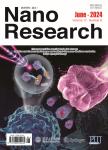Intelligent identification of two-dimensional nanostructures by machine-learning optical microscopy
Intelligent identification of two-dimensional nanostructures by machine-learning optical microscopy作者机构:Fert Beijing Research InstituteSchool ofMicroelectronics & Beijing Advanced Innovation Center for Big Data and Brain Computing (BDBC)Beihang UniversityBeijing 100191China Beihang-GoertekJoint Microelectronics InstituteQingdao Research InstituteBeihang UniversityQingdao 266000China Fert Beijing Research InstituteSchool of Computer Science and Engineering & Beijing Advanced Innovation Center for Big Data and Brain Computing (BDBC)Beihang UniversityBeijing 100191China State Key Laboratory of Low-Dimensional Quantum PhysicsDepartment of Physics & Tsinghua-Foxconn Nanotechnology Research CenterCollaborative Innovation Center of Quantum MatterTsinghua UniversityBeijing 100084China
出 版 物:《Nano Research》 (纳米研究(英文版))
年 卷 期:2018年第11卷第12期
页 面:6316-6324页
核心收录:
学科分类:0808[工学-电气工程] 07[理学] 0809[工学-电子科学与技术(可授工学、理学学位)] 0805[工学-材料科学与工程(可授工学、理学学位)] 0702[理学-物理学]
基 金:the National Natural Science Foundation of China (Nos.51602013,61602022 and 61627813) the National Basic Research Program of China (No.2012CB932301) the International Collaboration 111Project (No.B16001) Beijing Natural Science Foundation (No.4162039).
主 题:machine-learning optical identification two-dimensional (2D) material heterostructure artificial intelligence
摘 要:Two-dimensional (2D) materials and their heterostructures, with wafer-scale synthesis methods and fascinating properties, have attracted significant interest and triggered revolutions in corresponding device applications. However, facile methods to realize accurate, intelligent, and large-area characterizations of these 2D nanostructures are still highly desired. Herein, we report the successful application of machine-learning strategy in the optical identification of 2D nanostructures. The machine-learning optical identification (MOI) method endows optical microscopy with intelligent insight into the characteristic color information of 2D nanostructures in the optical photograph. The experimental results indicate that the MOI method enables accurate, intelligent, and large-area characterizations of graphene, molybdenum disulfide, and their heterostructures, including identifications of the thickness, existence of impurities, and even stacking order. With the convergence of artificial intelligence and nanoscience, this intelligent identification method can certainly promote fundamental research and wafer-scale device applications of 2D nanostructures.



